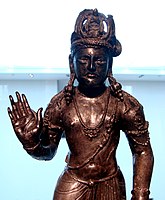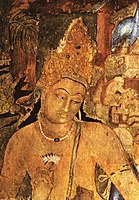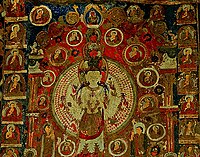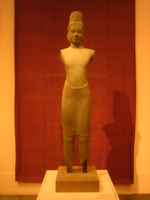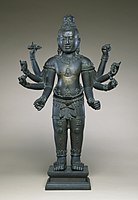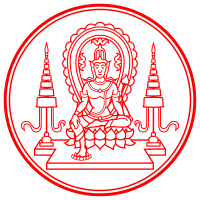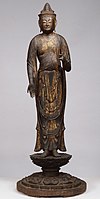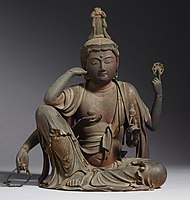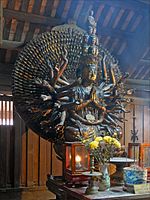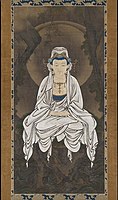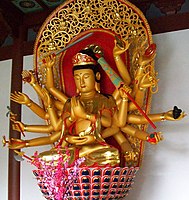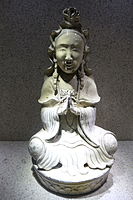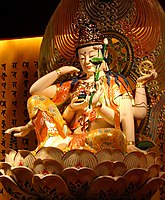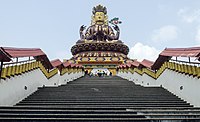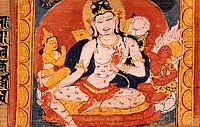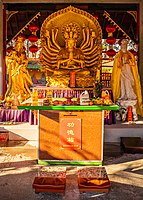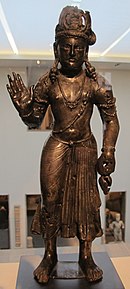Avalokiteśvara
| Avalokiteśvara | |
|---|---|
 | |
| Sanskrit |
|
| Burmese |
|
| Chinese |
|
| Japanese |
|
| Khmer |
|
| Korean |
|
| Russian |
|
| Thai |
|
| Tibetan | སྤྱན་རས་གཟིགས
|
| Vietnamese | Quan Âm, Quán Thế Âm, Quán Tự Tại |
| Information | |
| Venerated by | Buddhism, Chinese folk religion, Taoism |
| Attributes | Compassion |
In Buddhism, Avalokiteśvara (meaning "the lord who looks down",[1] IPA: /ˌʌvəloʊkɪˈteɪʃvərə/[2]), also known as Lokeśvara ("Lord of the World") and Chenrezig (in Tibetan), is a tenth-level bodhisattva associated with great compassion (mahakaruṇā). He is often associated with Amitabha Buddha.[3] Avalokiteśvara has numerous manifestations and is depicted in various forms and styles. In some texts, he is even considered to be the source of all Hindu deities (such as Vishnu, Shiva, Saraswati, Brahma, etc).[4]
While Avalokiteśvara was depicted as male in India, in East Asian Buddhism, Avalokiteśvara is most often depicted as a female figure known as Guanyin, Kannon, Gwaneum, and Quan Am in Chinese, Japanese, Korean, and Vietnamese, respectively.[5] Guanyin is also an important figure in other East Asian religions, particularly Chinese folk religion and Daoism.
Avalokiteśvara is also known for his popular mantra, oṃ maṇi padme hūṃ, which is the most popular mantra in Tibetan Buddhism.[6]
Etymology
[edit]The name Avalokiteśvara combines the verbal prefix ava "down", lokita, a past participle of the verb lok "to look, notice, behold, observe", here used in an active sense, and finally īśvara, "lord", "ruler", "sovereign", or "master". In accordance with sandhi (Sanskrit rules of sound combination), a+īśvara becomes eśvara. Combined, the parts mean "lord who gazed down (at the world)". The word loka ("world") is absent from the name, but the phrase is implied.[7] It does appear in the Cambodian form of the name, Lokesvarak.
The earliest translation of the name Avalokiteśvara into Chinese by authors such as Xuanzang was as Guānzìzài (Chinese: 觀自在; pinyin: Guān zìzài), not the form used in East Asian Buddhism today, which is Guanyin (Chinese: 觀音; pinyin: Guānyīn). It was initially thought that this was due to a lack of fluency, as Guanyin indicates the original Sanskrit form was instead Avalokitasvara, "who looked down upon sound", i.e., the cries of sentient beings who need help.[8] It is now understood that Avalokitasvara was the original form[9][10] and is also the origin of Guanyin "perceiving sound, cries". This translation was favored by the tendency of some Chinese translators, notably Kumārajīva, to use the variant GuānshìyīnChinese: 觀世音; pinyin: Guānshìyīn "who perceives the world's lamentations"—wherein lok was read as simultaneously meaning both "to look" and "world" (Sanskrit loka; Chinese: 世; pinyin: shì).[8] The original form of Guanyin's name appears in Sanskrit fragments from the fifth century.[11]
This earlier Sanskrit name was supplanted by the form containing the ending -īśvara "lord", but Avalokiteśvara did not occur in Sanskrit before the seventh century.
The original meaning of the name fits the Buddhist understanding of the role of a bodhisattva. The reinterpretation presenting him as an īśvara shows a strong influence of Hinduism, as the term īśvara was usually connected to the Hindu notion of Vishnu (in Vaishnavism) or Shiva (in Shaivism) as the Supreme Lord, Creator, and Ruler of the world. Some attributes of such a god were transmitted to the bodhisattva, but the mainstream of those who venerated Avalokiteśvara upheld the Buddhist rejection of the doctrine of any creator god.[12]
In Sanskrit, Avalokiteśvara is also referred to as Lokeśvara ("Lord of the World"). In Tibetan, Avalokiteśvara is Chenrézig (Tibetan: སྤྱན་རས་གཟིགས་). The etymology of the Tibetan name Chenrézik is spyan "eye", ras "continuity", and gzig "to look". This gives the meaning of one who always looks upon all beings (with the eye of compassion).[13]
Origin
[edit]Mahayana account
[edit]
The name Avalokiteśvara first appeared in the Avatamsaka Sutra, a Mahayana scripture that precedes the Lotus Sutra.[14] On account of its popularity in Japan and as a result of the works of the earliest Western translators of Buddhist Scriptures, the Lotus Sutra, however, has long been accepted as the earliest literature teaching about the doctrines of Avalokiteśvara. These are found in Chapter 25 of the Lotus Sutra: The Universal Gate of Bodhisattva Avalokiteśvara (Chinese: 觀世音菩薩普門品; pinyin: Guānshìyīn púsà pǔ mén pǐn). This chapter is devoted to Avalokiteśvara, describing him as a compassionate bodhisattva who hears the cries of sentient beings and who works tirelessly to help those who call upon his name. A total of 33 different manifestations of Avalokiteśvara are described, including female manifestations, all to suit the minds of various beings. The chapter consists of both a prose and a verse section. This earliest source often circulates separately as its own sutra, called the Avalokiteśvara Sūtra (Chinese: 觀世音經; pinyin: Guānshìyīn jīng), and is commonly recited or chanted at Buddhist temples in East Asia.[15]
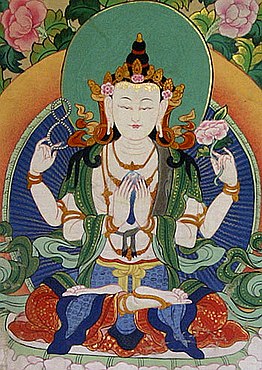
When the Chinese monk Faxian traveled to Mathura in India around 400 CE, he wrote about monks presenting offerings to Avalokiteśvara.[16] When Xuanzang traveled to India in the 7th century, he provided eyewitness accounts of Avalokiteśvara statues being venerated by devotees from all walks of life, from kings to monks to laypeople.[16]

In Chinese Buddhism and East Asia, Tangmi practices for the 18-armed form of Avalokiteśvara called Cundī are very popular. The popularity of Cundī is attested by the three extant translations of the Cundī Dhāraṇī Sūtra from Sanskrit to Chinese, made from the end of the seventh century to the beginning of the eighth century.[17] In late imperial China, these early esoteric traditions still thrived in Buddhist communities. Robert Gimello has also observed that in these communities, the esoteric practices of Cundī were extremely popular among both the populace and the elite.[18]
In the Tiantai school, six forms of Avalokiteśvara are defined. Each of the bodhisattva's six qualities is said to break the hindrances in one of the six realms of existence: hell-beings, pretas, animals, humans, asuras, and devas.
According to the prologue of Nīlakaṇṭha Dhāraṇī Sūtra, Gautama Buddha told his disciple Ānanda that Avalokiteśvara had become a Buddha from countless previous incarnations ago, alias Samyaka Dharma-vidya Tathāgata means "Tathāgata who clearly understood the right Dharma". Because of his great compassion and because he wanted to create proper conditions for all the Bodhisattva ranks and bring happiness and peacefulness to sentient beings, he became a Bodhisattva, taking the name of Avalokiteshvara and often abiding in the Sahā world. At the same time, Avalokiteśvara is also the attendant of Amitabha Buddha, assisting Amitabha Buddha to teach the Dharma in his Pure Land.
Theravāda account
[edit]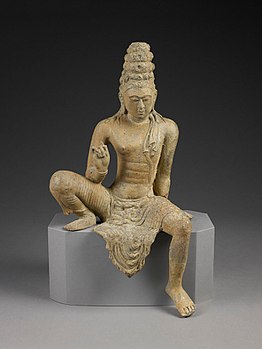
Veneration of Avalokiteśvara Bodhisattva has continued to the present day in Sri Lanka.
In times past, both Tantrayana and Mahayana have been found in some of the Theravada countries, but today the Buddhism of Sri Lanka (formerly, Ceylon), Myanmar (formerly, Burma), Thailand, Laos, and Cambodia is almost exclusively Theravada, based on the Pali Canon. The only Mahayana deity that has entered the worship of ordinary Buddhists in Theravada Buddhism is Bodhisattva Avalokitesvara. In Sri Lanka, he is known as Natha-deva and is mistaken by the majority for the Buddha yet to come, Bodhisattva Maitreya. The figure of Avalokitesvara is usually found in the shrine room near the Buddha image.[19]
In more recent times, some western-educated Theravādins have attempted to identify Nātha with Maitreya Bodhisattva; however, traditions and basic iconography (including an image of Amitābha Buddha on the front of the crown) identify Nātha as Avalokiteśvara.[20] Andrew Skilton writes:[21]
... It is clear from sculptural evidence alone that the Mahāyāna was fairly widespread throughout Sri Lanka, although the modern account of the history of Buddhism on the island presents an unbroken and pure lineage of Theravāda. (One can only assume that similar trends were transmitted to other parts of Southeast Asia with Sri Lankan ordination lineages.) Relics of an extensive cult of Avalokiteśvara can be seen in the present-day figure of Nātha.
Avalokiteśvara is popularly worshipped in Myanmar, where he is called Lokanat or lokabyuharnat, and Thailand, where he is called Lokesvara. The bodhisattva goes by many other names. In Indochina and Thailand, he is Lokesvara, "The Lord of the World". In Tibet, he is Chenrezig, also spelled Spyan-ras gzigs, "With a Pitying Look". In China, the bodhisattva takes a female form and is called Guanyin (also spelled Kwan Yin, Kuanyin, or Kwun Yum), "Hearing the Sounds of the World". In Japan, Guanyin is Kannon or Kanzeon; in Korea, Gwaneum; and in Vietnam, Quan Am.[22]

Modern scholarship
[edit]Avalokiteśvara is worshipped as Nātha in Sri Lanka. The Tamil Buddhist tradition developed in Chola literature, such as Buddamitra's Virasoliyam, states that the Vedic sage Agastya learned Tamil from Avalokiteśvara. The earlier Chinese traveler Xuanzang recorded a temple dedicated to Avalokitesvara in the south Indian Mount Potalaka, a Sanskritization of Pothigai, where Tamil Hindu tradition places Agastya as having learned the Tamil language from Shiva.[23][24][25] Avalokitesvara worship gained popularity with the growth of the Abhayagiri vihāra's Tamraparniyan Mahayana sect.

Western scholars have not reached a consensus on the origin of the reverence for Avalokiteśvara. Some have suggested that Avalokiteśvara, along with many other supernatural beings in Buddhism, was a borrowing or absorption by Mahayana Buddhism of one or more deities from Hinduism, in particular Shiva or Vishnu. This seems to be based on the name Avalokiteśvara.[11]
On the basis of the study of Buddhist scriptures and ancient Tamil literary sources as well as a field survey, Japanese scholar Shu Hikosaka proposes the hypothesis that ancient Mount Potalaka, the residence of Avalokiteśvara described in the Gaṇḍavyūha Sūtra and Xuanzang's Great Tang Records on the Western Regions, is Mount Potigai in Ambasamudram, Tirunelveli, at the Tamil Nadu-Kerala border.[26] Shu also said that Mount Potalaka has been a sacred place for the people of South India since time immemorial. It is the traditional residence of Siddhar Agastya at Agastya Mala. With the spread of Buddhism in the region beginning at the time of the great king Aśoka in the third century BCE, it became a holy place also for Buddhists, who gradually became dominant as a number of their hermits settled there. The local people, though, mainly remained followers of the Tamil animist religion. The mixed Tamil-Buddhist cult culminated in the formation of the figure of Avalokiteśvara.[27]
The name Lokeśvara should not be confused with that of Lokeśvararāja, the Buddha under whom Dharmakara became a monk and made forty-eight vows before becoming Amitābha.
Avalokiteśvara's six armed manifestation as Cintāmaṇicakra is also widely venerated in East Asia. The Cintāmaṇicakra Dharani (Chinese: 如意寶輪王陀羅尼; pinyin: Rúyì Bǎolún Wáng Tuóluóní) is another popular dharani associated with the bodhisattva.[28][29]
Mantras and Dharanis
[edit]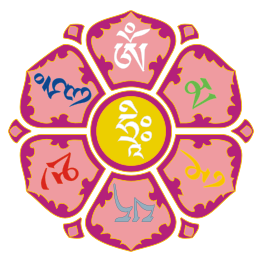
There are various mantras and dharanis associated with Avalokiteśvara.
Mani mantra
[edit]In Tibetan Buddhism, the central mantra is the six-syllable mantra oṃ maṇi padme hūṃ (Sanskrit: ॐ मणि पद्मे हूँ, also called the Mani mantra. Due to his association with this mantra, one form of Avalokiteśvara is called Ṣaḍākṣarī ("Lord of the Six Syllables") in Sanskrit. The Mani mantra is also popular in East Asian Mahayana. There are also different variations of the mani mantra, the most common which is oṃ maṇi padme hūṃ hrīḥ.[30] Hrīḥ is the seed syllable of the Lotus Buddha family and the Buddha Amitabha.
Recitation of this mantra while using prayer beads is the most popular religious practice in Tibetan Buddhism. Another popular religious practice associated with om mani padme hum is the spinning of prayer wheels clockwise, which contains numerous repetitions of this mantra and effectively benefits everyone within the vicinity of the practitioner.[31]
The connection between this famous mantra and Avalokiteśvara is documented for the first time in the Kāraṇḍavyūhasūtra. This text is dated to around the late 4th century CE to the early 5th century CE.[32] In this sūtra, a bodhisattva is told by the Buddha that recitation of this mantra while focusing on the sound can lead to the attainment of eight hundred samādhis.[33]
Ārolik mantra
[edit]Another mantra for Avalokiteśvara commonly recited in East Asian Buddhism is "three and a half syllables" (ardhacaturthākṣara) heart-mantra: "oṃ ārolik svāha" (or sometimes just Ārolik or oṁ ārolik), which is found (in many forms and variations like ārolika, arulika, etc.) in numerous pre-tenth-century Indian texts, including the 7th century Chinese translation of the Dhāraṇīsaṁgraha, the Susiddhikarasūtra, the Mañjuśriyamūlakalpa, and the Guhyasamājatantra.[34]
This is also the main mantra for the bodhisattva in Shingon Buddhism and is considered to be the main mantra of the Lotus Buddha family.[35][36][37]
One text (Taisho Tripitaka no. 1031) describes a visualization practice done after reciting oṁ ārolik svāhā seven times which includes meditating on the meanings of the four letters of ārolik which are:[34]
- a: all dharmas are originally unborn (ādyanutpanna);
- ra: all dharmas are dissociated from defilement (rajas);
- la: characteristics (lakṣaṇa) are inapprehensible in all dharmas;
- ka: all dharmas are without action (kārya).
The Ārolik mantra has also been found engraved on a few sculptures found in north India. One of these begins with "ārolik oṁ hrīḥ". Another one of these found in Bihar also included other mantras, including ye dharma hetu, followed by "namo ratnatrayāya namo Āryāvalokiteśvarāya bodhisatvāya mahāsatvāya mahākāruṇikāya Ārolok Oṁ hriḥ hriḥ".[34]
Another longer mantra appears in a translation by Amoghavajra (T. 1033, 20: 9b1–7):[34]
namoratnatrayāya | nama āryāvalokiteśvarāya bodhisattvāya mahāsattvāya mahākāruṇikāya | tadyathā padmapāṇi sara sara ehy ehi bhagavann āryāvalokiteśvara ārolik |
In Chinese, oṃ ārolik svāha is pronounced Ǎn ālǔlēi jì suōpóhē (唵 阿嚕勒繼 娑婆訶). In Korean, it is pronounced Om aroreuk Ge Sabaha (옴 아로늑계 사바하). In Japanese, it is pronounced On arori kya sowa ka (おん あろりきゃ そわか).
Dharanis
[edit]The Kāraṇḍavyūha Sūtra also features the first appearance of the dhāraṇī of Cundī, which occurs at the end of the sūtra text.[17] After the bodhisattva finally attains samādhi with the mantra "oṃ maṇipadme hūṃ", he is able to observe 77 koṭīs of fully enlightened buddhas replying to him in one voice with the Cundī Dhāraṇī: namaḥ saptānāṃ samyaksaṃbuddha koṭīnāṃ tadyathā, oṃ cale cule cunde svāhā.[38]
The Nīlakaṇṭha Dhāraṇī is an 82-syllable dhāraṇī for Avalokiteśvara also known as the Great Compassion Mantra. It is very popular in East Asian Buddhism. Another popular Avalokiteśvara dharani in East Asian Buddhism is Eleven-Faced Avalokitesvara Heart Dharani. This dharani is associated with Avalokiteśvara's eleven face form, known as Ekādaśamukha, one of the six forms of Guanyin.
East Asian chants and phrases
[edit]In East Asian Buddhism, the most popular form of Avalokiteśvara is the feminine white robed Guanyin. A common phrase which is widely chanted and recited by East Asian Buddhists is:
Chinese: 南無觀世音菩薩, Pinyin: Námó Guānshìyīn Púsà (Japanese: Namu Kanzeon Bosatsu)
In English: Homage to Guanyin Bodhisattva. There are also longer chants, usually termed "White Robed Guanyin" (Baiyin Guanyin) sutras (jing) or mantras (zhou).[39] The most well known is the "Divine White-robed Guanyin Mantra" (c. 11th century).[39] This longer mantra is as follows:[40]
南無 大慈 大悲 救苦 救難 廣大 靈感 觀世音 菩薩 (Námó dàcí dàbēi jiùkǔ jiùnàn guǎngdà línggǎn Guānshìyīn púsà)
English: Homage to Guanyin Bodhisattva [who is] loving, compassionate and powerful, delivering sentient beings from unhappiness and hardship.
南無佛南無法南無僧 (Námó Fó Námó Fǎ Námó Sēng, Homage to the Buddha, Homage to the Dharma, Homage to the Sangha)
南無 救苦 救難 觀世音 菩薩 (Námó jiùkǔ jiùnàn Guānshìyīn púsà)
English: Homage to Guanyin Bodhisattva who delivers sentient beings from unhappiness and hardship
怛垤哆唵 伽囉伐哆伽囉伐哆伽訶佛哆 囉伽佛哆囉伽佛哆娑婆訶 (DA ZHI DUO ONG QIE LA FA DUO QIE LA FA DUO QIE HE FA DUO LA QIE FA DUO LA QIE FA DUO SA PO HE)
Sanskrit Mantra: Tadyatha Om, khara varta, khara varta, gaha varta, raga varta, raga varta, Svaha
天羅神 地羅神 人離難 難離身 一切 災殃 化 為塵。
Tiān luó shén Dì luó shén Rén lí nán Nán lí shēn Yīqiè zāiyāng huà wéichén
English: Heavenly deities and earthly deities, may people be free from difficulties, may their hardships disappear, may all disasters and calamities turn to dust.
南無 摩訶 般若波羅蜜 (Námó Móhē Bōrěbōluómi)
English: Homage to Mahāprajñāpāramitā
Another popular dharani of Guanyin is associated with her power over children and childbirth. This is called the "Dharani Sutra of White-Robed Guanyin's Heart of Five Seals".[39] In Japanese Buddhism, a popular longer chant to Kannon or Kanzeon (Guanyin) is the jikku kan'on gyō (十句觀音經), the "10 Verse Kannon Sutra". It is the following:[41]
觀世音 (kan ze on)
南無佛 (na mu butsu): Homage to Buddha
與佛有因 (yo butsu u in): forged a causal connection with Buddha,
與佛有縁 (yo butsu u en): a karmic affinity with Buddha,
佛法僧縁 (butsu ho so en): a karmic affinity with Buddha, Dharma, Sangha
常樂我淨 (jo raku ga jo): thus attaining permanence, ease, selfhood, and purity.
朝念觀世音 (cho nen kan ze on): In the morning think of Kanzeon,
暮念觀世音 (bo nen kan ze on): in the evening think of Kanzeon.
念念從心起 (nen nen ju shin ki): Thought after thought arises from mind;
念念不離心 (nen nen fu ri shin): thought after thought is not separate from mind.
Manifestations
[edit]

Avalokiteśvara has an extraordinarily large number of forms, emanations or manifestations, including wisdom goddesses (vidyās) directly associated with him in images and texts.
Furthermore, at least two separate female Buddhist deities, Cundī and Tara also later came to be associated with Avalokiteśvara (and were even seen as manifestations of him).
Some of the more commonly mentioned forms include:[42][43][44]
| Sanskrit name | Meaning | Description |
|---|---|---|
| Āryāvalokiteśvara | Noble Avalokiteśvara | The root form of the Bodhisattva |
| Caturbhuja Lokeśvara | "Four armed" Lokeśvara | Two hands in anjali, one hand holds a lotus, the other hand holds a mala |
| Padmapani | Lotus in hand | Holds a vase and a lotus |
| Ekādaśamukha | Eleven Faced | Additional faces to teach all in 10 planes of existence |
| Sahasrabhuja | Thousand-Armed, Thousand-Eyed Avalokitesvara | White, with multiple arms holding many symbols |
| Sahasranetra | Thousand-eyed | Often depicted with multiple arms with eyes on the hands |
| Cintāmaṇicakra | Wish Fulfilling Wheel | Holds the wish-fulfilling jewel (cintamani) and the wheel (chakra) |
| Hayagrīva | Horse-necked one | Wrathful form; simultaneously bodhisattva and a Wisdom King |
| Amoghapāśa | Unfailing noose | Avalokitesvara with rope and net |
| Nīlakaṇṭhāvalokiteśvara | Dark blue necked | Dark blue in color |
| Siṃhanādalokeśvara | Lord with the voice of a lion | Seated on a roaring lion |
| Harihariharivāha | Triple Hari | Appears with Vishnu and Garuda |
| Sṛṣṭikartā Lokeśvara | Avalokiteshvara in the process of creation | Red in color, shown emanating numerous devas |
| Jinasagara Avalokiteśvara | Ocean of conquerors, also known as "Red Chenrezig" | A Vajrayana form, often depicted with a female consort |
| Khasarpaṇi Lokeśvara | "Sky flyer" Lokeśvara | White, two harms, holds a lotus |
| Gaṇapati | Ganesha | |
| Bhṛkuti | Fierce-Eyed | |
| Sadakṣarī | Six Syllables | |
| Śvetabhagavatī | White Lord | |
| Udakaśrī | Auspicious Water | |
| Lokanātha Kala Lokeshvara | Lord of worlds Black Lokeshvara | A wrathful tantric form with 12 arms |
Thousand-armed Avalokiteśvara
[edit]
One prominent Buddhist story tells of Avalokiteśvara vowing never to rest until he had freed all sentient beings from saṃsāra. Despite strenuous effort, he realizes that many unhappy beings were yet to be saved. After struggling to comprehend the needs of so many, his head splits into eleven pieces. Amitābha, seeing his plight, gives him eleven heads with which to hear the cries of the suffering. Upon hearing these cries and comprehending them, Avalokiteśvara tries to reach out to all those who needed aid, but found that his two arms shattered into pieces. Once more, Amitābha comes to his aid and invests him with a thousand arms with which to aid the suffering multitudes.[45]
Avalokiteśvara as a cosmic maheśvara ("great lord")
[edit]
According to various Mahayana sources, numerous Hindu deities are considered to be emanations of Avalokiteshvara. For example, in the Kāraṇḍavyūhasūtra, Vishnu, Shiva, Brahma and Saraswati are all said to have emerged from Avalokiteshvara.[4] The passage states:
Āditya and Candra came from his eyes, Maheśvara came from his forehead, Brahmā came from his shoulders, Nārāyaṇa came from his heart, Devi Sarasvatī came from his canines, Vāyu came from his mouth, Dharaṇī came from his feet, and Varuṇa came from his stomach.[46]
In a similar manner, Hindu deities like Nīlakaṇṭha and Harihara are cited in the Nīlakaṇṭha Dhāraṇī, possibly as forms of Avalokiteshvara or as associated bodhisattvas (the text is not clear, though traditionally these have been interpreted as various names or forms of Avalokiteshvara).[47]
Alexander Studholme writes that these sources are influenced by Puranic Hinduism, and its concepts of an Īśvara ("lord") and Maheśvara ("great lord"), both of which are terms that refer to a transcendent and all pervasive being.[48] The name Maheśvara is also applied to Avalokiteshvara three times in the Kāraṇḍavyūhasūtra, and some passages he is described as a cosmic man, similar to how the Puranas depict Vishnu or Shiva.[48] However, this Buddhist myth only focuses on how Avalokiteshvara gives birth to all the gods (devas), and he is not depicted as a true Creator God (who creates the cosmos, like the Hindu Īśvara), instead he is depicted as a great cosmic being that manifests in myriad ways as a skillful means to guide living beings to Buddhahood.[49]
Tibetan Buddhist beliefs
[edit]Avalokiteśvara is an important deity in Tibetan Buddhism. He is regarded in the Vajrayana teachings as a Buddha.[50]
In Tibetan Buddhism, Tãrã came into existence from a single tear shed by Avalokiteśvara.[5] When the tear fell to the ground it created a lake, and a lotus opening in the lake revealed Tara. In another version of this story, Tara emerges from the heart of Avalokiteśvara. In either version, it is Avalokiteśvara's outpouring of compassion which manifests Tãrã as a being.[51][52][53]
Certain living tulku lineages, including the Dalai Lamas and the Karmapas, are considered by many Tibetan Buddhists to also be manifestations of Avalokiteśvara.[54][55][56]
Gallery
[edit]-
Indian cave wall painting of Avalokiteśvara. Ajaṇṭā Caves, 6th century CE.
-
Avalokitesvara, ca 11th-12th Century CE, Pala Period
-
Avalokitesvara, Pala period
-
1000-armed Avalokiteśvara dated 13th - 15th century AD at Saspol cave (Gon-Nila-Phuk Cave Temples and Fort) in Ladakh, India
-
Cambodian statue of Avalokiteśvara. Sandstone, 7th century CE.
-
Avalokiteśvara sandstone statue, late 7th century CE.
-
Avalokiteśvara andesite stone in Mendut temple, early 9th century Sailendran art, Java, Indonesia.
-
Eight-armed Avalokiteśvara, ca. 12th-13th century (Bàyon). The Walters Art Museum.
-
Avalokiteśvara from Bingin Jungut, Musi Rawas, South Sumatra. Srivijayan art (c. 8th-9th century CE)
-
The bronze torso Avalokiteshvara of Chaiya, 8th century CE Srivijayan art, Chaiya District, Surat Thani Province, Southern Thailand.
-
The Privy Seal of King Ananda Mahidol of Thailand show a picture of a Bodhisattva, based on a Srivijayan sculpture of Avalokiteśvara Padmapani which was found at Chaiya District, Surat Thani Province.
-
Chinese statue of Avalokiteśvara looking out over the sea, c. 1025 CE.
-
Standing Kannon Bosatsu (Avalokitesvara), 12th century, Heian period, Tokyo National Museum, Japan.
-
Senju Kannon by Tankei, 13th century, Sanjūsangen-dō, Japan.
-
Nyoirin Kannon, 1275, Tokyo National Museum, Japan
-
Korean painting of Avalokiteśvara. Kagami Jinjya, Japan, 1310 CE.
-
Nepalese statue of Avalokiteśvara with six arms. 14th century CE.
-
Avalokiteśvara of One Thousand Arms, lacquered and gilded wood. Restored in 1656 CE. Bút Tháp Temple, Bắc Ninh Province, Vietnam
-
Tibetan statue of Avalokiteśvara with eleven faces.
-
Japanese painting of Avalokiteśvara meditating. 16th century CE.
-
Tang dynasty (896 AD) carved stone statue of Qianshou Guanyin in Shengshui Temple (內江聖水寺) in Neijiang, Sichuan, China
-
The world tallest octagonal pavilion to shelter the Guanyin statue in Kek Lok Si in Air Itam, Penang, Malaysia.
-
Esoteric Cundī form of Avalokiteśvara with eighteen arms in Lingyin Temple in Hangzhou, Zhejiang Province, China.
-
Thousand-armed Avalokiteśvara bronze statue from Tibet, circa 1750. Birmingham Museum of Art
-
Quan Âm (Avalokiteśvara) statue in the 18th - 19th centuries at the Vietnam National Museum of History, Hanoi, Vietnam
-
2 statues of Quan Âm (Avalokiteśvara) in the Nguyễn dynasty at the Vietnam National Museum of History, Vietnam
-
Quán Âm (Avalokiteśvara) figurine, Bát Tràng kiln, Hanoi, Nguyễn dynasty, 19th century AD, white glazed ceramic - Vietnam National Museum of History, Vietnam
-
Statue of Avalokiteśvara (Migjid Janraisig) in Gandantegchinlen Monastery, Ulaanbaatar, Mongolia. The tallest indoor statue in the world, 26.5-meter-high, 1996 rebuilt, (1913)
-
Statue of Ruyilun Guanyin (Cintamanicakra) in the Buddha Tooth Relic Temple and Museum in Chinatown, Singapore.
-
Statue of Avalokiteśvara, date unknown, bronze and gold
-
Painting of Avalokitesvara Bodhisattva. Sanskrit Astasahasrika Prajnaparamita Sutra manuscript written in the Ranjana script. Nalanda, Bihar, India. Circa 700-1100 CE
-
Qianshou Guanyin at Cham Shan Temple in Hong Kong, China
-
Statue of Shiyimian Guanyin in Ten Thousand Buddhas Monastery (萬佛寺) in Pai Tau Village, Sha Tin, Hong Kong
-
The wooden statue of thousand-armed and thousand-eyed Guanyin at the City of Ten Thousand Buddhas in Ukiah, California.
See also
[edit]- Virupaksha Temple, Hampi
- Guanyin
- Ishvara
- Pure Land Buddhism
- Ushnishasitatapattra
- Vishnu
- Dalai Lama
- Pha Trelgen Changchup Sempa
References
[edit]- ^ Gour, H. S. (1929). The Spirit Of Buddhism Vol. 1. p. 10.
- ^ "Avalokitesvara". Random House Webster's Unabridged Dictionary.
- ^ Ellwood, Robert S. (2008). The Encyclopedia of World Religions. Facts on file. p. 40. ISBN 978-1-4381-1038-7.
- ^ a b Studholme, Alexander (2002). The Origins of Om Manipadme Hum: A Study of the Karandavyuha Sutra. State University of New York Press. p. 39-40.
- ^ a b Leighton, Taigen Dan (1998). Bodhisattva Archetypes: Classic Buddhist Guides to Awakening and Their Modern Expression. New York: Penguin Arkana. pp. 158–205. ISBN 0140195564. OCLC 37211178.
- ^ Studholme, Alexander (2002). The Origins of Om Manipadme Hum: A Study of the Karandavyuha Sutra. State University of New York Press. p. 2.
- ^ Studholme p. 52-54, 57.
- ^ a b Pine, Red. The Heart Sutra: The Womb of the Buddhas (2004) Shoemaker 7 Hoard. ISBN 1-59376-009-4 pg 44–45
- ^ Lokesh Chandra (1984). "The Origin of Avalokitesvara" (PDF). Indologica Taurinensia. XIII (1985–1986). International Association of Sanskrit Studies: 189–190. Archived from the original (PDF) on June 6, 2014. Retrieved 26 July 2014.
- ^ Mironov, N. D. (1927). "Buddhist Miscellanea". Journal of the Royal Asiatic Society of Great Britain and Ireland. 59 (2): 241–252. doi:10.1017/S0035869X00057440. JSTOR 25221116. S2CID 250344585.
- ^ a b Studholme p. 52-57.
- ^ Studholme p. 30-31, 37–52.
- ^ Bokar Rinpoche (1991). Chenrezig Lord of Love – Principles and Methods of Deity Meditation. San Francisco, California: Clearpoint Press. p. 15. ISBN 0-9630371-0-2.
- ^ Huntington, John (2003). The Circle of Bliss: Buddhist Meditational Art: p. 188
- ^ Baroni, Helen (2002). The Illustrated Encyclopedia of Zen Buddhism: p. 15
- ^ a b Ko Kok Kiang. Guan Yin: Goddess of Compassion. 2004. p. 10
- ^ a b Studholme, Alexander (2002). The Origins of Oṃ Maṇipadme Hūṃ: A Study of the Kāraṇḍavyūha Sūtra: p. 175
- ^ Jiang, Wu (2008). Enlightenment in Dispute: The Reinvention of Chan Buddhism in Seventeenth-Century China: p. 146
- ^ Baruah, Bibhuti. Buddhist Sects and Sectarianism. 2008. p. 137
- ^ "Art & Archaeology – Sri Lanka – Bodhisattva Avalokiteshvara".
- ^ Skilton, Andrew. A Concise History of Buddhism. 2004. p. 151
- ^ "Meet Avalokiteshvara, Buddhism's Bodhisattva of Infinite Compassion".
- ^ Iravatham Mahadevan (2003), EARLY TAMIL EPIGRAPHY, Volume 62. pp. 169
- ^ Kallidaikurichi Aiyah Nilakanta Sastri (1963) Development of Religion in South India – Page 15
- ^ Layne Ross Little (2006) Bowl Full of Sky: Story-making and the Many Lives of the Siddha Bhōgar, pp. 28
- ^ Hirosaka, Shu. The Potiyil Mountain in Tamil Nadu and the origin of the Avalokiteśvara cult
- ^ Läänemets, Märt (2006). "Bodhisattva Avalokiteśvara in the Gandavyuha Sutra". Chung-Hwa Buddhist Studies 10, 295–339. Retrieved 2009-09-12.
- ^ "Ten Small Mantras". www.buddhamountain.ca. Retrieved 2021-05-10.
- ^ "What is Ten Small Mantras". www.buddhismtoronto.com. Retrieved 2021-05-10.
- ^ Bucknell, Roderick & Stuart-Fox, Martin (1986). The Twilight Language: Explorations in Buddhist Meditation and Symbolism. Curzon Press: London. ISBN 0-312-82540-4, p. 15.
- ^ Studholme, Alexander (2002). The Origins of Oṃ Maṇipadme Hūṃ: A Study of the Kāraṇḍavyūha Sūtra: p. 2
- ^ Studholme, Alexander (2002) The Origins of Oṃ Maṇipadme Hūṃ: A Study of the Kāraṇḍavyūha sūtra: p. 17
- ^ Studholme, Alexander (2002). The Origins of Oṃ Maṇipadme Hūṃ: A Study of the Kāraṇḍavyūha Sūtra: p. 106
- ^ a b c d Nicolas Revire, Rajat Sanyal, Rolf Giebel. Avalokiteśvara of the “Three and a Half Syllables”: A Note on the Heart-Mantra Ārolik in India. Arts Asiatiques, 2021, Arts Asiatiques, 76, pp.5–30. ⟨10.3406/arasi.2021.2095⟩. ⟨halshs-04142356⟩
- ^ Shingon Buddhist International Institute. "Jusan Butsu – The Thirteen Buddhas of the Shingon School". Archived from the original on 1 April 2013. Retrieved 5 July 2007.
- ^ Hutchins, Steven J (2015). Thirteen Buddhas: Tracing the Roots of the Thirteen Buddha Rites, Introduction. Vivlia Limited
- ^ The Koyasan Shingon-shu Lay Practitioner's Daily Service Archived 2 May 2006 at the Wayback Machine, Shingon Buddhist International Institute (1999)
- ^ "Saptakoṭibuddhamātṛ Cundī Dhāraṇī Sūtra". Lapis Lazuli Texts. Retrieved 24 July 2013.
- ^ a b c Berger, Patricia Ann; Foresman, Helen. Latter Days of the Law: Images of Chinese Buddhism, 850 – 1850, p. 172. University of Hawaii Press, Jan 1, 1994.
- ^ "聖嚴法師教觀音法門 27". old.ddc.shengyen.org. Retrieved 2024-08-14.
- ^ "Glossary – individual | SOTOZEN.COM". www.sotozen.com. Retrieved 2024-08-14.
- ^ Getty, Alice (2011-05-29). "The gods of northern Buddhism: their history, iconography and progressive evolution through the northern Buddhist countries – The Principal Forms Of Avalokitesvara [Chapter VI]". www.wisdomlib.org. Retrieved 2023-12-12.
- ^ "Buddhist Deity: Avalokiteshvara (Wrathful/Semi Forms)". www.himalayanart.org. Retrieved 2023-12-12.
- ^ D., Orzech, Charles (2011). Esoteric buddhism and the tantras in East Asia, p. 215. Brill. ISBN 978-90-04-18491-6. OCLC 716806704.
- ^ Venerable Shangpa Rinpoche. "Arya Avalokitesvara and the Six Syllable Mantra". Dhagpo Kagyu Ling. Archived from the original on 27 September 2007. Retrieved 2007-10-17.
- ^ "The Basket's Display / 84000 Reading Room". 84000 Translating The Words of The Buddha. Retrieved 2023-12-11.
- ^ Chandra, Lokesh (1988). The Thousand-armed Avalokiteśvara, pp. 130–133. New Delhi: Abhinav Publications, Indira Gandhi National Centre for the Arts. ISBN 81-7017-247-0.
- ^ a b Studholme, Alexander (2002). The Origins of Om Manipadme Hum: A Study of the Karandavyuha Sutra. State University of New York Press. p. 38.
- ^ Studholme, Alexander (2002). The Origins of Om Manipadme Hum: A Study of the Karandavyuha Sutra. State University of New York Press. pp. 44–45.
- ^ Еше-Лодой Рипоче. Краткое объяснение сущности Ламрима. Спб.-Улан-Удэ, 2002. С. 19 (in Russian)
- ^ Dampa Sonam Gyaltsen (1996). The Clear Mirror: A Traditional Account of Tibet's Golden Age. Shambhala. p. 21. ISBN 978-1-55939-932-6.
- ^ Shaw, Miranda (2006). Buddhist Goddesses of India. Princeton University Press. p. 307. ISBN 0-691-12758-1.
- ^ Bokar Tulku Rinpoche (1991). Chenrezig, Lord of Love: Principles and Methods of Deity Meditation. ClearPoint Press. ISBN 978-0-9630371-0-7.
- ^ "From Birth to Exile". The Office of His Holiness the Dalai Lama. Archived from the original on 20 October 2007. Retrieved 2007-10-17.
- ^ Martin, Michele (2003). "His Holiness the 17th Gyalwa Karmapa". Music in the Sky: The Life, Art, and Teachings of the 17th Karmapa. Karma Triyana Dharmachakra. Archived from the original on 14 October 2007. Retrieved 2007-10-17.
- ^ "Glossary". Dhagpo Kundreul Ling. Archived from the original on 2007-08-08. Retrieved 2007-10-17.
Sources
[edit]- Buswell, Robert; Lopez, Donald S. (2013). The Princeton Dictionary of Buddhism. Princeton University Press. ISBN 978-0-691-15786-3.
- Doniger, Wendy, ed. (1993), Purana Perennis: Reciprocity and Transformation in Hindu and Jaina Texts, State University of New York Press, ISBN 0-7914-1381-0
- Ducor, Jérôme (2010). Le regard de Kannon (in French). Gollion: Infolio éditions / Genève: Musée d'ethnographie de Genève. p. 104. ISBN 978-2-88474-187-3. ill. colour
- Getty, Alice (1914). The gods of northern Buddhism: their history, iconography and progressive evolution through the northern Buddhist countries. Oxford: Clarendon Press.
- Holt, John (1991). Buddha in the Crown: Avalokitesvara in the Buddhist Traditions of Sri Lanka. New York: Oxford University Press. ISBN 0195064186.
- McDermott, James P. (1999). "Buddha in the Crown: Avalokitesvara in the Buddhist Traditions of Sri Lanka". Journal of the American Oriental Society. 119 (1): 195–196. doi:10.2307/605604. JSTOR 605604.
- Studholme, Alexander (2002). The Origins of Om Manipadme Hum. Albany NY: State University of New York Press. ISBN 0-7914-5389-8.
- Tsugunari, Kubo; Akira (tr.), Yuyama (2007). The Lotus Sutra (PDF) (Revised 2nd ed.). Berkeley, Calif.: Numata Center for Buddhist Translation and Research. ISBN 978-1-886439-39-9. Archived from the original (PDF) on 2015-07-02.
- Yü, Chün-fang (2001). Kuan-Yin: The Chinese Transformation of Avalokitesvara. Columbia University Press. ISBN 978-0-231-12029-6.
External links
[edit]- The Origin of Avalokiteshvara of Potala
- An Explanation of the Name Avalokiteshvara
- The Bodhisattva of Compassion and Spiritual Emanation of Amitabha – from Buddhanature.com
- Depictions at the Bayon in Cambodia of Avalokiteshvara as the Khmer King Jayavarman VII
- Mantra Avalokitesvara
- Avalokiteshvara at Britannica.com
- Chenrezig Tibetan Buddhist Center of Philadelphia

